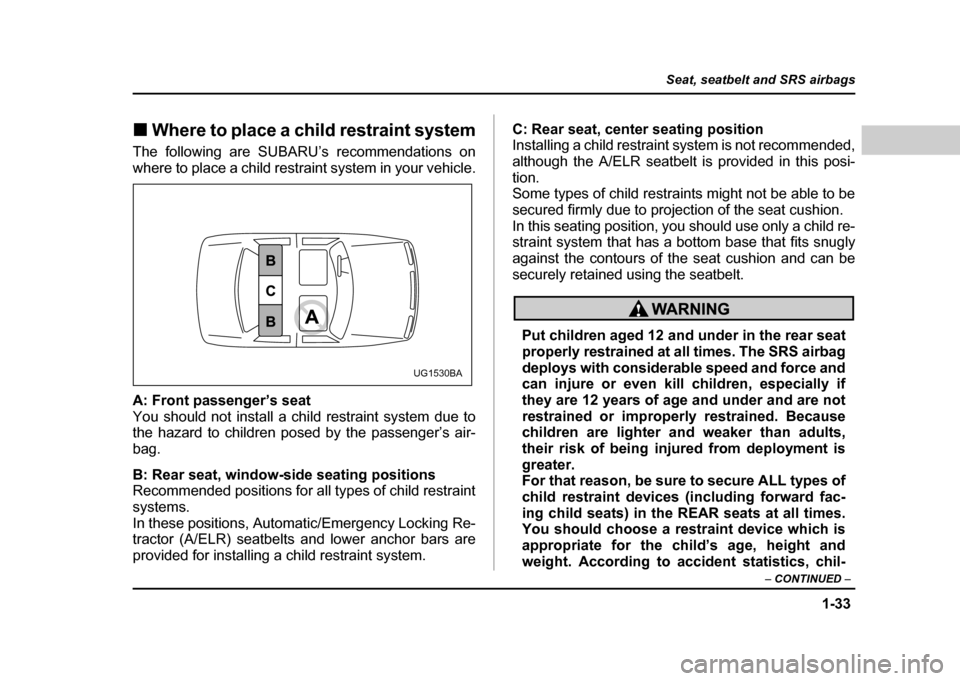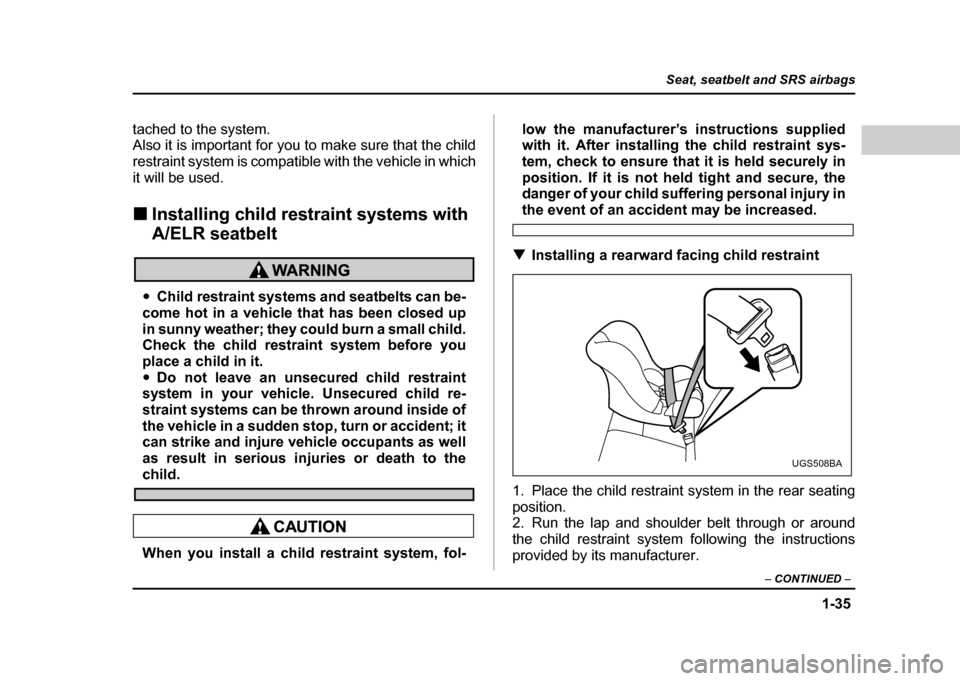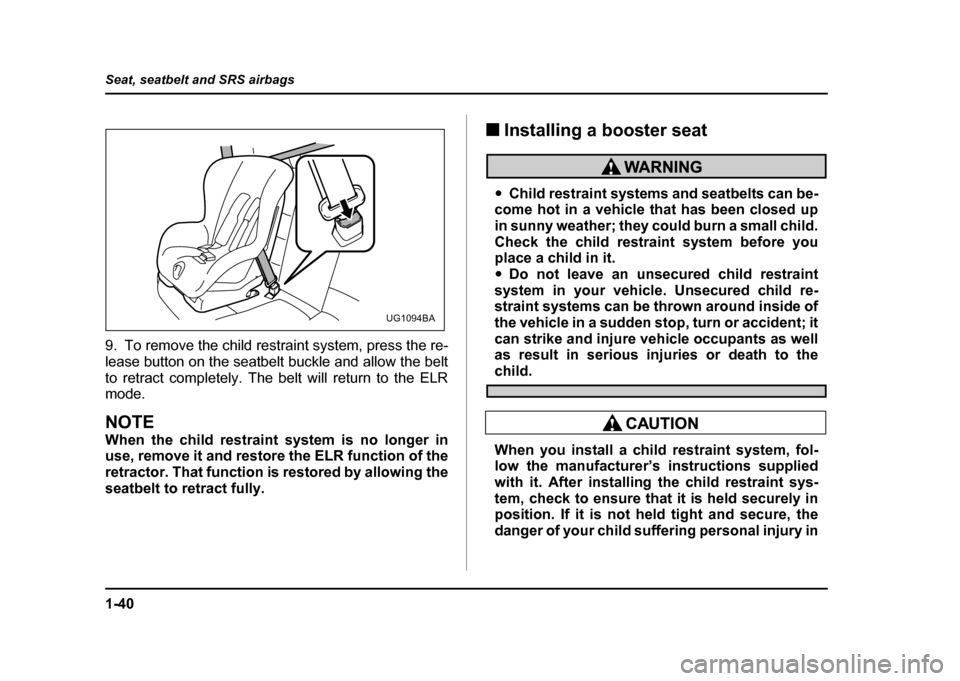Page 60 of 491

1-33
Seat, seatbelt and SRS airbags
– CONTINUED –
!Where to place a child restraint system
The following are SUBARU’s recommendations on
where to place a child restraint system in your vehicle.
A: Front passenger’s seat
You should not install a child restraint system due to
the hazard to children posed by the passenger’s air-
bag.
B: Rear seat, window-side seating positions
Recommended positions for all types of child restraint systems.
In these positions, Automatic/Emergency Locking Re-
tractor (A/ELR) seatbelts and lower anchor bars are
provided for installing a child restraint system. C: Rear seat, center seating position
Installing a child restraint system is not recommended,
although the A/ELR seatbelt is provided in this posi-
tion.
Some types of child restraints might not be able to be
secured firmly due to projection of the seat cushion.
In this seating position, you should use only a child re-
straint system that has a bottom base that fits snugly
against the contours of the seat cushion and can be
securely retained using the seatbelt.
Put children aged 12 and under in the rear seat
properly restrained at all times. The SRS airbag
deploys with considerable speed and force and
can injure or even kill children, especially if
they are 12 years of age and under and are not
restrained or improperly restrained. Because
children are lighter and weaker than adults,
their risk of being injured from deployment is
greater.
For that reason, be sure to secure ALL types of
child restraint devices (including forward fac-
ing child seats) in the REAR seats at all times.
You should choose a restraint device which is
appropriate for the child’s age, height and
weight. According to accident statistics, chil-
UG1530BA
Page 61 of 491
1-34
Seat, seatbelt and SRS airbags
dren are safer when properly restrained in the
rear seating positions than in the front seating
positions.
SINCE YOUR VEHICLE IS EQUIPPED WITH A PASSENGER’S SRS AIRBAG, NEVER INSTALL
A REARWARD FACING CHILD SAFETY SEAT
IN THE FRONT PASSENGER’S SEAT. DOING SO RISKS SERIOUS INJURY OR DEATH TO
THE CHILD BY PLACING THE CHILD’S HEAD
TOO CLOSE TO THE SRS AIRBAG.
! Choosing a child restraint system
Choose a child restraint system that is appropriate for
the child’s age and size (weight and height) in order to
provide the child with proper protection. The child re-
straint system should meet all applicable requirements
of Federal Motor Vehicle Safety Standards for the
United States or of Canada Motor Vehicle Safety
Standards for Canada. It can be identified by looking
for the label on the child restraint system or the manu-
facturer’s statement of compliance in the document at-
HG1043BAUGS507AA
Page 62 of 491

1-35
Seat, seatbelt and SRS airbags
– CONTINUED –
tached to the system.
Also it is important for you to make sure that the child
restraint system is compatible with the vehicle in which
it will be used. !Installing child restraint systems with
A/ELR seatbelt
"Child restraint systems and seatbelts can be-
come hot in a vehicle that has been closed up
in sunny weather; they could burn a small child.
Check the child restraint system before you
place a child in it." Do not leave an unsecured child restraint
system in your vehicle. Unsecured child re-
straint systems can be thrown around inside of
the vehicle in a sudden stop, turn or accident; it
can strike and injure vehicle occupants as well
as result in serious injuries or death to the
child.
When you install a child restraint system, fol- low the manufacturer’s instructions supplied
with it. After installing the child restraint sys-
tem, check to ensure that it is held securely in
position. If it is not held tight and secure, the
danger of your child suffering personal injury in
the event of an accident may be increased.
! Installing a rearward facing child restraint
1. Place the child restraint system in the rear seating
position.
2. Run the lap and shoulder belt through or around
the child restraint system following the instructions
provided by its manufacturer.
UGS508BA
Page 63 of 491
1-36
Seat, seatbelt and SRS airbags
3. Insert the tongue plate into the buckle until you
hear a click.
4. Take up the slack in the lap belt.
5. Pull out the seatbelt fully from the retractor to
change the retractor over from the Emergency Lock-
ing Retractor (ELR) to the Automatic Locking Retrac-
tor (ALR) function. Then, allow the belt to rewind into
the retractor. As the belt is rewinding, clicks will be
heard which indicate the retractor functions as ALR.
6. Push and pull the child restraint system forward
and from side to side to check if it is firmly secured.
Sometime a child restraint can be more firmly secured
by pushing it down into the seat cushion and then
tightening the seat belt.
7. Pull at the shoulder portion of the belt to confirm
that it cannot be pulled out (ALR properly functioning).
UGS509BA
UGS510BA
Page 64 of 491
1-37
Seat, seatbelt and SRS airbags
– CONTINUED –
8. To remove the child restraint system, press the re-
lease button on the seatbelt buckle and allow the belt
to retract completely. The belt will return to the ELR
mode.
NEVER INSTALL A REARWARD FACING CHILD
SEAT IN THE FRONT PASSENGER’S SEAT.
DOING SO RISKS SERIOUS INJURY OR DEATH
TO THE CHILD BY PLACING THE CHILD’S
HEAD TOO CLOSE TO THE SRS AIRBAG.
NOTE
When the child restraint system is no longer in
use, remove it and restore the ELR function of the
retractor. That function is restored by allowing the
seatbelt to retract fully. !Installing forward facing child restraint
1. Place the child restraint system in the rear seating
position.
2. Run the lap and shoulder belt through or around
the child restraint system following the instructions
provided by its manufacturer.
3. Insert the tongue plate into the buckle untill you
hear a click.
UG1089BA
US1581BA
Page 65 of 491
1-38
Seat, seatbelt and SRS airbags
4. Take up the slack in the lap belt.
5. Pull out the seatbelt fully from the retractor to
change the retractor over from the Emergency Lock-
ing Retractor (ELR) to the Automatic Locking Retrac-
tor (ALR) function. Then, allow the belt to rewind into
the retractor. As the belt is rewinding, clicks will be
heard which indicate the retractor functions as ALR.
6. Before having a child sit in the child restraint sys-
tem, move it back and forth and right and left to check
if it is firmly secured. Sometimes a child restraint can
be more firmly secured by pushing it down into the
seat cushion and then tightening the seatbelt.
7. Pull at the shoulder portion of the belt to confirm
that it cannot be pulled out (ALR properly functioning).
US1582BAUS1583BA
Page 66 of 491
1-39
Seat, seatbelt and SRS airbags
– CONTINUED –
Sedan Wagon
8. If the child restraint system requires a top tether,
latch the hook onto the top tether anchor and tighten
the top tether. See the “Top tether anchorages” for ad-
ditional instructions.
UG1087BAUG1088BA
Page 67 of 491

1-40
Seat, seatbelt and SRS airbags
9. To remove the child restraint system, press the re-
lease button on the seatbelt buckle and allow the belt
to retract completely. The belt will return to the ELR
mode.
NOTE
When the child restraint system is no longer in
use, remove it and restore the ELR function of the
retractor. That function is restored by allowing the
seatbelt to retract fully.
!
Installing a booster seat
"Child restraint systems and seatbelts can be-
come hot in a vehicle that has been closed up
in sunny weather; they could burn a small child.
Check the child restraint system before you
place a child in it. " Do not leave an unsecured child restraint
system in your vehicle. Unsecured child re-
straint systems can be thrown around inside of
the vehicle in a sudden stop, turn or accident; it
can strike and injure vehicle occupants as well
as result in serious injuries or death to the
child.
When you install a child restraint system, fol-
low the manufacturer’s instructions supplied
with it. After installing the child restraint sys-
tem, check to ensure that it is held securely in
position. If it is not held tight and secure, the
danger of your child suffering personal injury in
UG1094BA